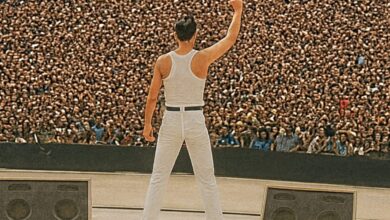Brian May Joins Andrea Bocelli for a Stunning Performance of “Who Wants to Live Forever” Honoring Freddie Mercury
Andrea Bocelli’s 2024 Teatro del Silenzio was always bound to be unforgettable, yet no one could have anticipated the breathtaking twist awaiting the audience when Brian May walked onto the stage. On July 19, the grand finale of the “30: The Celebration” trilogy, the legendary Queen guitarist joined the world’s most celebrated tenor in a luminous performance of “Who Wants to Live Forever.” Beneath Tuscany’s velvet sky, rock and opera merged into something that felt more like a sacred ritual than a concert. The amphitheater itself became a cathedral of sound, where history was not merely remembered but inscribed into the night air.
The song carries its own weight of sorrow and beauty. Written by May in 1986 for Highlander, it was born from reflections on love, mortality, and inevitable loss. Freddie Mercury’s incomparable interpretation transformed it into one of Queen’s most haunting ballads, balancing fragility with grandeur. To unite May—the composer—with Bocelli’s soaring tenor was to summon a dialogue between past and present, creating not only a tribute to Mercury but a redefinition of what immortality in music can signify.
The atmosphere shifted the instant May arrived. His Red Special, gleaming under the lights, carried with it the resonance of countless arenas and anthems. Bocelli stood poised beside him, dignified and unshaken, a figure whose voice had graced the ears of royalty and spiritual leaders alike. In that moment, they embodied two worlds—decades apart yet suddenly united in one tableau of artistry.
May’s first chords were intimate, like threads of memory stitched into the air. Then Bocelli entered, his tenor lifting those chords into a fragile yet mighty prayer. When May’s gravel-tinged voice followed, raw and unvarnished, it met Bocelli’s crystalline clarity in a harmony both startling and sublime. Two contrasting timbres, instead of clashing, revealed themselves as natural complements—opposites designed to converge.
From the opening refrain, silence engulfed the amphitheater. No coughs, no whispers—just stillness until the orchestra surged in. Strings rose like Tuscany’s hills, expanding the song’s scope, while the valleys and ridges of Lajatico reverberated the sound back. The landscape itself became part of the performance, echoing Freddie’s spirit into the night, binding land, sky, and song as one living entity.
Equally moving was the connection between the two men. Days before, May had posted a rehearsal clip, playfully guiding Bocelli through a guitar line with laughter. That warmth carried into the stage, preventing stiffness and infusing the collaboration with intimacy. May leaned into Bocelli’s refinement, while Bocelli embraced May’s raw emotion, and together they crafted a dialogue built on trust and artistic generosity.
Bocelli’s operatic strength reshaped the piece far beyond its rock roots, transforming Mercury’s part into something noble yet deeply vulnerable. He did not mimic; he expanded. May’s guitar, ever faithful to Queen’s essence, wove counterpoint harmonies that grounded the piece in its origin. The performance became less a cover and more an evolution—an act of bridging genres, cultures, and eras with one sweeping gesture.
The crescendo was staggering. Bocelli’s voice ascended skyward while May’s guitar cried out above the orchestra—equal parts mourning and triumph. When the final note dissolved into silence, the amphitheater erupted—not in simple applause, but in a roar of release, as if gratitude itself demanded to be voiced by everyone present.
Through the pro-shot video, the wider world was invited into Tuscany’s magic. Cameras captured every detail: May’s fingers darting across the Red Special, violin bows fraying with intensity, eyes glimmering with tears. Audiences across continents could step into that amphitheater, immersed in a cinematic rendering of unfiltered emotion and artistry.
The performance became a crown jewel of Andrea Bocelli 30: The Celebration, the film preserving the three-night spectacle. Amid a roster of stars—Ed Sheeran, Shania Twain, Jon Batiste—the duet stood apart, its gravity undeniable, a singular moment in a constellation of dazzling collaborations.
The venue itself amplified the magic. Teatro del Silenzio, silent for most of the year before awakening in summer, adds its own weight to every event. Its acoustics ripple across the Tuscan countryside, and its profound stillness frames each note with sacred intensity. To hear May’s guitar spill into the valleys as Bocelli’s tenor soared above was to hear not just music, but geography and eternity woven together.
Across the internet, the awe was echoed. Rock fans marveled at Bocelli’s respectful interpretation of Mercury’s lines, while classical purists praised May’s raw, untrained yet deeply expressive delivery. Comments flooded in like devotions: “pure magic,” “a hymn of goosebumps,” “the most human of prayers.” One rose above the rest: “To hear the writer of the song with Andrea channeling Freddie—it’s perfection itself.”
The evening featured more than one shared stage. May also accompanied Bocelli on “Because We Believe,” a gentle precursor that prepared hearts for the emotional storm of “Who Wants to Live Forever.” The sequencing felt deliberate, an operatic act unfolding note by note, guiding the audience toward its inevitable catharsis.
In hindsight, their duet was not just homage but resurrection. May carried Queen’s sorrow and brilliance, while Bocelli wrapped it in operatic grandeur and timeless poise. The result was a reminder that music can outlive voice, genre, and time—becoming something larger than its creators, something eternal.
With its release by Decca Records and Mercury Studios in 2025, the performance became permanent. No longer confined to a Tuscan night, it joined the enduring legacies of both artists. Proof that when rock’s raw flame collides with opera’s soaring grace, the outcome is not merely a song—it is eternity given sound.





